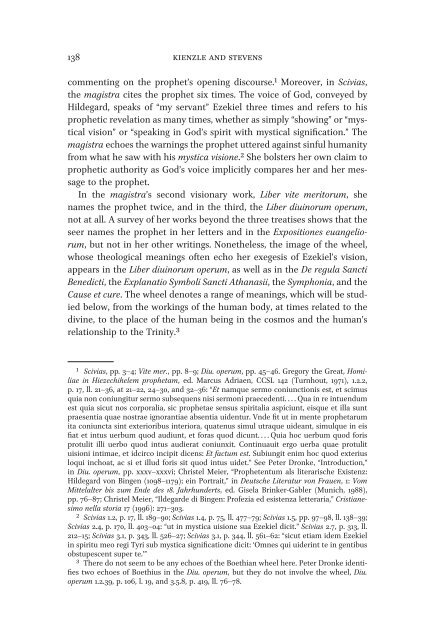A Companion to Hildegard of Bingen
Beverly Mayne Kienzle, Debra L. Stoudt & George Ferzoco, "A Companion to Hildegard of Bingen". BRILL, Leiden - Boston, 2014.
Beverly Mayne Kienzle, Debra L. Stoudt & George Ferzoco, "A Companion to Hildegard of Bingen". BRILL, Leiden - Boston, 2014.
- TAGS
- hildegard-of-bingen
Create successful ePaper yourself
Turn your PDF publications into a flip-book with our unique Google optimized e-Paper software.
138 kienzle and stevens<br />
commenting on the prophet’s opening discourse.1 Moreover, in Scivias,<br />
the magistra cites the prophet six times. The voice <strong>of</strong> God, conveyed by<br />
<strong>Hildegard</strong>, speaks <strong>of</strong> “my servant” Ezekiel three times and refers <strong>to</strong> his<br />
prophetic revelation as many times, whether as simply “showing” or “mystical<br />
vision” or “speaking in God’s spirit with mystical signifijication.” The<br />
magistra echoes the warnings the prophet uttered against sinful humanity<br />
from what he saw with his mystica visione.2 She bolsters her own claim <strong>to</strong><br />
prophetic authority as God’s voice implicitly compares her and her message<br />
<strong>to</strong> the prophet.<br />
In the magistra’s second visionary work, Liber vite meri<strong>to</strong>rum, she<br />
names the prophet twice, and in the third, the Liber diuinorum operum,<br />
not at all. A survey <strong>of</strong> her works beyond the three treatises shows that the<br />
seer names the prophet in her letters and in the Expositiones euangeliorum,<br />
but not in her other writings. Nonetheless, the image <strong>of</strong> the wheel,<br />
whose theological meanings <strong>of</strong>ten echo her exegesis <strong>of</strong> Ezekiel’s vision,<br />
appears in the Liber diuinorum operum, as well as in the De regula Sancti<br />
Benedicti, the Explanatio Symboli Sancti Athanasii, the Symphonia, and the<br />
Cause et cure. The wheel denotes a range <strong>of</strong> meanings, which will be studied<br />
below, from the workings <strong>of</strong> the human body, at times related <strong>to</strong> the<br />
divine, <strong>to</strong> the place <strong>of</strong> the human being in the cosmos and the human’s<br />
relationship <strong>to</strong> the Trinity.3<br />
1 Scivias, pp. 3–4; Vite mer., pp. 8–9; Diu. operum, pp. 45–46. Gregory the Great, Homiliae<br />
in Hiezechihelem prophetam, ed. Marcus Adriaen, CCSL 142 (Turnhout, 1971), 1.2.2,<br />
p. 17, ll. 21–36, at 21–22, 24–30, and 32–36: “Et namque sermo coniunctionis est, et scimus<br />
quia non coniungitur sermo subsequens nisi sermoni praecedenti. . . . Qua in re intuendum<br />
est quia sicut nos corporalia, sic prophetae sensus spiritalia aspiciunt, eisque et illa sunt<br />
praesentia quae nostrae ignorantiae absentia uidentur. Vnde fijit ut in mente prophetarum<br />
ita coniuncta sint exterioribus interiora, quatenus simul utraque uideant, simulque in eis<br />
fijiat et intus uerbum quod audiunt, et foras quod dicunt. . . . Quia hoc uerbum quod foris<br />
protulit illi uerbo quod intus audierat coniunxit. Continuauit ergo uerba quae protulit<br />
uisioni intimae, et idcirco incipit dicens: Et factum est. Subiungit enim hoc quod exterius<br />
loqui inchoat, ac si et illud foris sit quod intus uidet.” See Peter Dronke, “Introduction,”<br />
in Diu. operum, pp. xxxv–xxxvi; Christel Meier, “Prophetentum als literarische Existenz:<br />
<strong>Hildegard</strong> von <strong>Bingen</strong> (1098–1179); ein Portrait,” in Deutsche Literatur von Frauen, 1: Vom<br />
Mittelalter bis zum Ende des 18. Jahrhunderts, ed. Gisela Brinker-Gabler (Munich, 1988),<br />
pp. 76–87; Christel Meier, “Ildegarde di <strong>Bingen</strong>: Pr<strong>of</strong>ezia ed esistenza letteraria,” Cristianesimo<br />
nella s<strong>to</strong>ria 17 (1996): 271–303.<br />
2 Scivias 1.2, p. 17, ll. 189–90; Scivias 1.4, p. 75, ll. 477–79; Scivias 1.5, pp. 97–98, ll. 138–39;<br />
Scivias 2.4, p. 170, ll. 403–04: “ut in mystica uisione sua Ezekiel dicit.” Scivias 2.7, p. 313, ll.<br />
212–15; Scivias 3.1, p. 343, ll. 526–27; Scivias 3.1, p. 344, ll. 561–62: “sicut etiam idem Ezekiel<br />
in spiritu meo regi Tyri sub mystica signifijicatione dicit: ‘Omnes qui uiderint te in gentibus<br />
obstupescent super te.’”<br />
3 There do not seem <strong>to</strong> be any echoes <strong>of</strong> the Boethian wheel here. Peter Dronke identifijies<br />
two echoes <strong>of</strong> Boethius in the Diu. operum, but they do not involve the wheel, Diu.<br />
operum 1.2.39, p. 106, l. 19, and 3.5.8, p. 419, ll. 76–78.
















